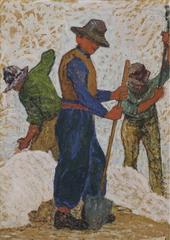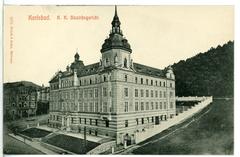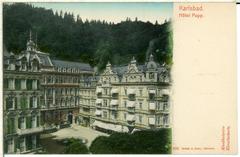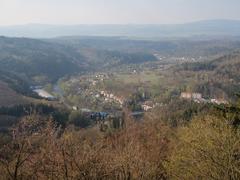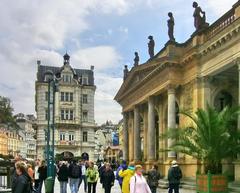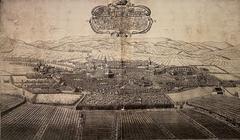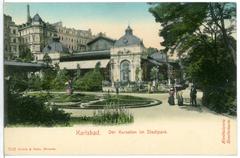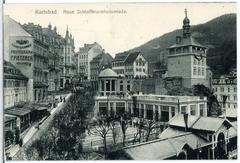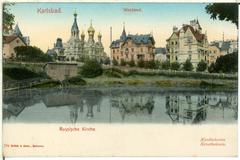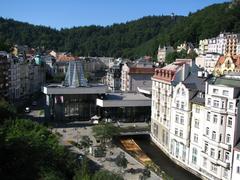Watermelon House Karlovy Vary: Visiting Hours, Tickets, and Travel Guide
Date: 04/07/2025
Introduction
Nestled in the heart of Karlovy Vary, the Watermelon House (Dům U Melounu) stands out as a whimsical testament to the city’s rich spa heritage and architectural diversity. Its playful watermelon-shaped ornament and vibrant façade make it a favorite stop for photographers, art lovers, and tourists exploring this historic Bohemian spa town. Whether you’re interested in the site’s history, practical visiting details, or tips for experiencing local culture and cuisine, this comprehensive guide provides all you need to know for a memorable visit to the Watermelon House and its surroundings (Karlovy Vary Historical Buildings, Touristplaces Guide, Adventure Backpack).
Table of Contents
- Historical Background
- Architectural Significance
- Cultural and Social Role
- Practical Visitor Information
- Accessibility and Amenities
- Local Culture, Cuisine, and Seasonal Considerations
- Nearby Attractions
- Integrating Watermelon House into Your Visit
- Visitor Tips
- Frequently Asked Questions (FAQ)
- Conclusion
- References and Further Reading
Historical Background
The Watermelon House is an iconic example of Karlovy Vary’s tradition of naming buildings after unique symbols before street numbering was standardized. Dating back to the 18th century, its watermelon-themed façade reflects both the city’s creative spirit and its cosmopolitan history as a renowned European spa destination. Over time, the building has served various purposes—housing shops, businesses, and residences—cementing its status at the heart of the town’s social and commercial life (Karlovy Vary Historical Buildings, Sandaltanman: Things to Do in Karlovy Vary).
Architectural Significance
Facade and Ornamentation
The Watermelon House’s façade is a lively display of late Baroque and Neo-Renaissance styles, with intricate stucco work, pilasters, and window frames. The signature watermelon motif above the entrance is both a nod to local tradition and a playful artistic flourish, emblematic of Karlovy Vary’s blend of elegance and whimsy (Karlovy Vary Historical Buildings).
Preservation and Urban Context
Situated on Tržiště Street, the house is part of a protected UNESCO World Heritage district, surrounded by a continuous row of historic buildings that exemplify the city’s layered architectural history. Stringent local heritage regulations ensure the building’s original features are preserved during renovations (UNESCO Karlovy Vary).
Cultural and Social Role
Symbolism and Local Identity
The Watermelon House is more than an architectural curiosity; it encapsulates the spirit of Karlovy Vary as a meeting place of cultures, languages, and traditions. Its recognizable motif helped visitors navigate the town in centuries past and continues to represent the city’s warm, welcoming atmosphere.
Connection to Spa Culture
Located among the city’s famed colonnades and springs, the Watermelon House has long been a part of the spa experience—serving guests en route to wellness rituals and acting as a hub for social interaction (Adventure Backpack: Karlovy Vary Landmarks). The street-level shops and cafés historically catered to the needs of spa-goers and travelers.
Artistic and Photographic Appeal
The house’s unique façade and picturesque setting have made it a perennial favorite for artists and photographers. Its colorful exterior, especially when illuminated by the soft light of morning or evening, is emblematic of Karlovy Vary’s visual charm.
Practical Visitor Information
Location
Watermelon House is located at Stará Louka 16, 360 01 Karlovy Vary, along the scenic Stará Louka promenade by the Teplá River. This central position puts it within easy walking distance of major sites like the Mill Colonnade, Market Colonnade, and Grandhotel Pupp (touristplaces.guide).
Visiting Hours and Tickets
- Exterior Viewing: The Watermelon House is primarily an outdoor attraction. There are no standard interior tours, and the façade can be admired at any time during daylight hours.
- Admission: No tickets are required to view or photograph the building from outside.
- Special Events: On rare occasions, private events or special guided tours may include interior access. Inquire at the local tourist information center for current opportunities (Karlovy Vary Information Centre).
Best Times to Visit
- Spring and Autumn: For fewer crowds and optimal lighting, visit in the morning or late afternoon during spring or autumn.
- Summer: Expect higher foot traffic, especially during the Karlovy Vary International Film Festival (adventurebackpack.com).
- Winter: Enjoy a quieter, magical atmosphere with festive markets and snowy cityscapes (timetravella.com).
Accessibility and Amenities
Getting There
Karlovy Vary is accessible from Prague via direct bus or train (2–3 hours). From the main transport hubs, it’s a 15–20 minute walk to Stará Louka. Taxis and bicycle rentals are available for those with mobility concerns (expats.cz).
Physical Accessibility
- Promenade: Stará Louka is mostly flat and pedestrian-friendly, suitable for wheelchairs and strollers, though some cobblestones and minor slopes remain.
- Building Access: The Watermelon House entrance may have steps, and no public elevator is visible, so interior access may be limited for some visitors.
Amenities
- Nearby: Numerous cafés, restaurants, and shops line the promenade.
- Restrooms: Public facilities are available in the colonnade areas and larger hotels.
- Tourist Information: The local center offers maps, brochures, and assistance in multiple languages (Karlovy Vary Information Centre).
Local Culture, Cuisine, and Seasonal Considerations
Spa Heritage
Karlovy Vary’s spa culture is central to its identity. Strolling the colonnades, sipping mineral water from spa cups, and participating in wellness rituals are time-honored traditions (adventurebackpack.com).
Artistic and Festive Atmosphere
The city hosts art festivals, music events, and folklore celebrations year-round, often taking place within walking distance of Watermelon House (passporterapp.com).
Local Cuisine
- Signature Dishes: Svíčková na smetaně (marinated beef with creamy sauce), goulash, and šopský salát.
- Sweet Treats: Trdelník (sugar-coated pastry).
- Drinks: Becherovka (herbal liqueur) and Czech beers (theworldwasherefirst.com).
- Dining: Riverside cafés and bistros offer atmospheric settings.
Seasonal Tips
- Spring/Autumn: Mild weather, colorful scenery, and manageable crowds (best-time.to).
- Summer: Peak season with lively events—arrive early for photos.
- Winter: Festive markets and snow; some attractions may have reduced hours (whereandwhen.net).
Nearby Attractions
- Stará Louka Street: Picturesque promenade ideal for leisurely walks (Foreigners.cz).
- Mlýnská Kolonáda (Mill Colonnade): Renaissance-style colonnade with mineral springs (The Tourist Checklist).
- Market Colonnade: Intricate wooden colonnade sheltering hot springs.
- Diana Observation Tower: Panoramic views of the city and forests (The Tourist Checklist).
- Jeleni Skok Rock: Scenic lookout with local legend (Foreigners.cz).
- Grandhotel Pupp: Iconic hotel with historic dining rooms (Tourspilot.com).
- Orthodox Church of St. Peter and Paul: Striking golden-domed church (Terrahunt.com).
- Moser Glass Museum: Showcasing Bohemian glassmaking (The Tourist Checklist).
- Loket Castle: 12th-century fortress accessible by bus or tour (Foreigners.cz).
Integrating Watermelon House into Your Visit
- Walking Tour Start: Begin your exploration at Watermelon House and continue along Stará Louka, visiting colonnades and the observation tower.
- Spa Experience: Sample mineral waters and book treatments at nearby spas (Draft Itinerary).
- Culinary Pairings: Enjoy traditional meals at riverside restaurants and sample Becherovka.
- Day Trips: Extend your stay with excursions to Loket Castle or the Moser Glass Museum (Tourspilot.com).
- Seasonal Highlights: Attend the International Film Festival in summer or enjoy Christmas markets in winter.
Visitor Tips
- Photography: Visit early or late in the day for the best light and fewer crowds.
- Footwear: Wear comfortable shoes for cobblestone streets.
- Accessibility: While the promenade is mostly level, check ahead for assistance if mobility is a concern.
- Souvenirs: Spa wafers, Moser glass, and Becherovka are popular choices (The Tourist Checklist).
Frequently Asked Questions (FAQ)
Q: Can I enter Watermelon House?
A: The house is privately owned; public interior tours are not available. Admire the façade from the outside.
Q: Are tickets required to visit?
A: No, exterior visits are free. Guided walking tours may include the site.
Q: What are the best visiting hours?
A: Daylight hours are ideal, especially early morning or late afternoon for photography.
Q: Is Watermelon House accessible for wheelchairs?
A: The promenade is accessible, but the building’s entrance may have steps.
Q: Are guided tours available?
A: Yes, several local operators offer historical walking tours featuring Watermelon House (getyourguide.com).
Conclusion
The Watermelon House is a vibrant emblem of Karlovy Vary’s spa culture, artistic heritage, and welcoming spirit. Its distinctive façade, central location, and rich historical context make it a must-see for any visitor. While interior access is limited, the site’s photogenic charm and proximity to other major attractions provide a rewarding experience. Enhance your trip with guided tours, sample local cuisine, and immerse yourself in the city’s seasonal festivities.
For personalized audio guides and up-to-date visitor information, consider downloading the Audiala app. Check official tourism resources for the latest events and practical details, and make the most of your journey through one of Europe’s most enchanting spa towns.
